brake sensor HONDA HR-V 2019 Owner's Manual (in English)
[x] Cancel search | Manufacturer: HONDA, Model Year: 2019, Model line: HR-V, Model: HONDA HR-V 2019Pages: 631, PDF Size: 39.76 MB
Page 28 of 631
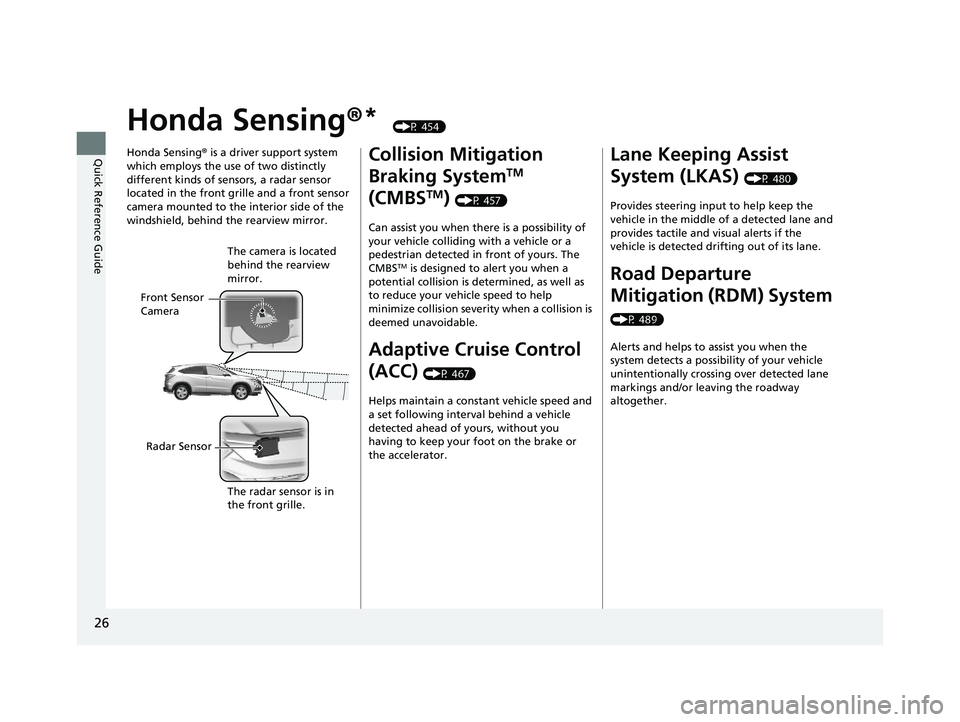
26
Quick Reference Guide
Honda Sensing®* (P 454)
Honda Sensing ® is a driver support system
which employs the use of two distinctly
different kinds of sensors, a radar sensor
located in the front grille and a front sensor
camera mounted to the interior side of the
windshield, behind the rearview mirror.
Front Sensor
Camera The camera is located
behind the rearview
mirror.
Radar Sensor The radar sensor is in
the front grille.
Collision Mitigation
Braking System
TM
(CMBS
TM) (P 457)
Can assist you when there is a possibility of
your vehicle colliding with a vehicle or a
pedestrian detected in front of yours. The
CMBS
TM is designed to alert you when a
potential collision is determined, as well as
to reduce your vehicle speed to help
minimize collision severity when a collision is
deemed unavoidable.
Adaptive Cruise Control
(ACC)
(P 467)
Helps maintain a constant vehicle speed and
a set following interval behind a vehicle
detected ahead of yours, without you
having to keep your foot on the brake or
the accelerator.
Lane Keeping Assist
System (LKAS)
(P 480)
Provides steering input to help keep the
vehicle in the middle of a detected lane and
provides tactile and visual alerts if the
vehicle is detected drifting out of its lane.
Road Departure
Mitigation (RDM) System
(P 489)
Alerts and helps to assist you when the
system detects a possibility of your vehicle
unintentionally crossing over detected lane
markings and/or leaving the roadway
altogether.
19 HR-V HDMC HDMG-31T7A6300.book 26 ページ 2018年6月1日 金曜日 午後1時14分
Page 107 of 631
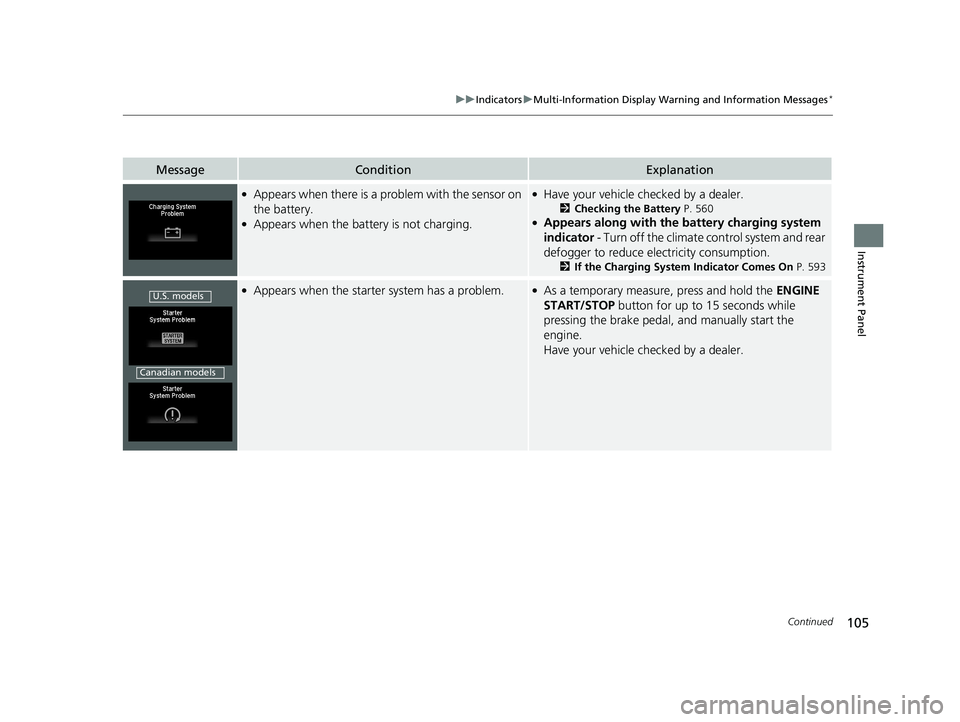
105
uuIndicators uMulti-Information Display Warn ing and Information Messages*
Continued
Instrument Panel
MessageConditionExplanation
●Appears when there is a problem with the sensor on
the battery.
●Appears when the battery is not charging.
●Have your vehicle checked by a dealer.
2 Checking the Battery P. 560●Appears along with the ba ttery charging system
indicator - Turn off the climate control system and rear
defogger to reduce electricity consumption.
2 If the Charging System Indicator Comes On P. 593
●Appears when the starter system has a problem.●As a temporary measure, press and hold the ENGINE
START/STOP button for up to 15 seconds while
pressing the brake pedal, and manually start the
engine.
Have your vehicle checked by a dealer.U.S. models
Canadian models
19 HR-V HDMC HDMG-31T7A6300.book 105 ページ 2018年6月1日 金曜日 午後1時14分
Page 108 of 631
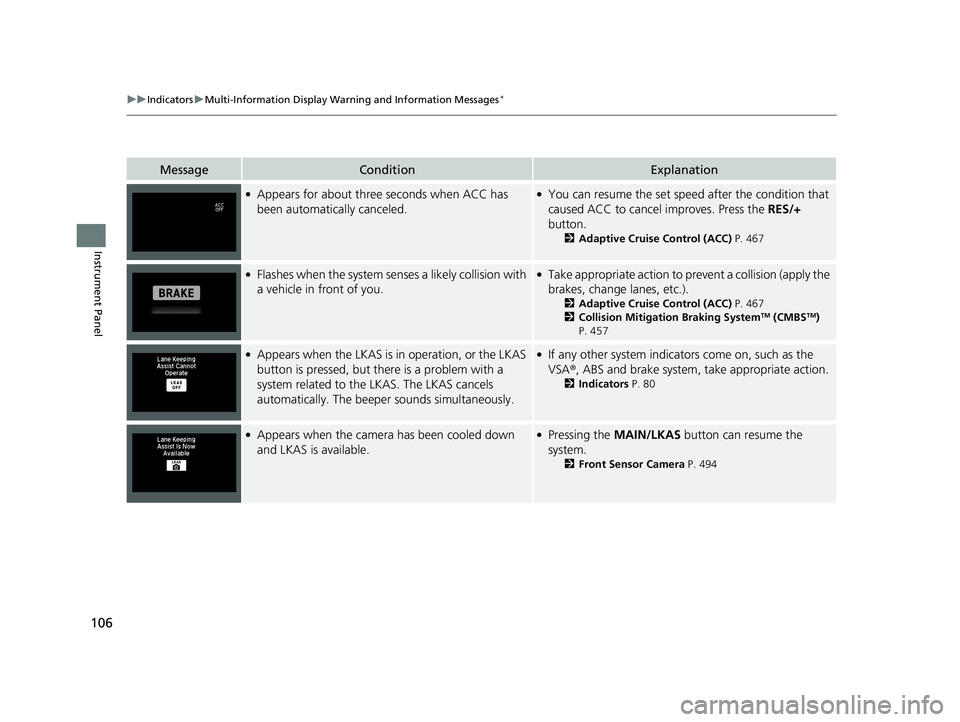
106
uuIndicators uMulti-Information Display Warn ing and Information Messages*
Instrument Panel
MessageConditionExplanation
●Appears for about three seconds when ACC has
been automatically canceled.●You can resume the set speed after the condition that
caused ACC to cancel improves. Press the RES/+
button.
2 Adaptive Cruise Control (ACC) P. 467
●Flashes when the system senses a likely collision with
a vehicle in front of you.●Take appropriate action to prev ent a collision (apply the
brakes, change lanes, etc.).
2 Adaptive Cruise Control (ACC) P. 467
2 Collision Mitigation Braking SystemTM (CMBSTM)
P. 457
●Appears when the LKAS is in operation, or the LKAS
button is pressed, but there is a problem with a
system related to the LKAS. The LKAS cancels
automatically. The beeper sounds simultaneously.●If any other system indicato rs come on, such as the
VSA ®, ABS and brake system, take appropriate action.
2Indicators P. 80
●Appears when the camera has been cooled down
and LKAS is available.●Pressing the MAIN/LKAS button can resume the
system.
2 Front Sensor Camera P. 494
19 HR-V HDMC HDMG-31T7A6300.book 106 ページ 2018年6月1日 金曜日 午後1時14分
Page 197 of 631
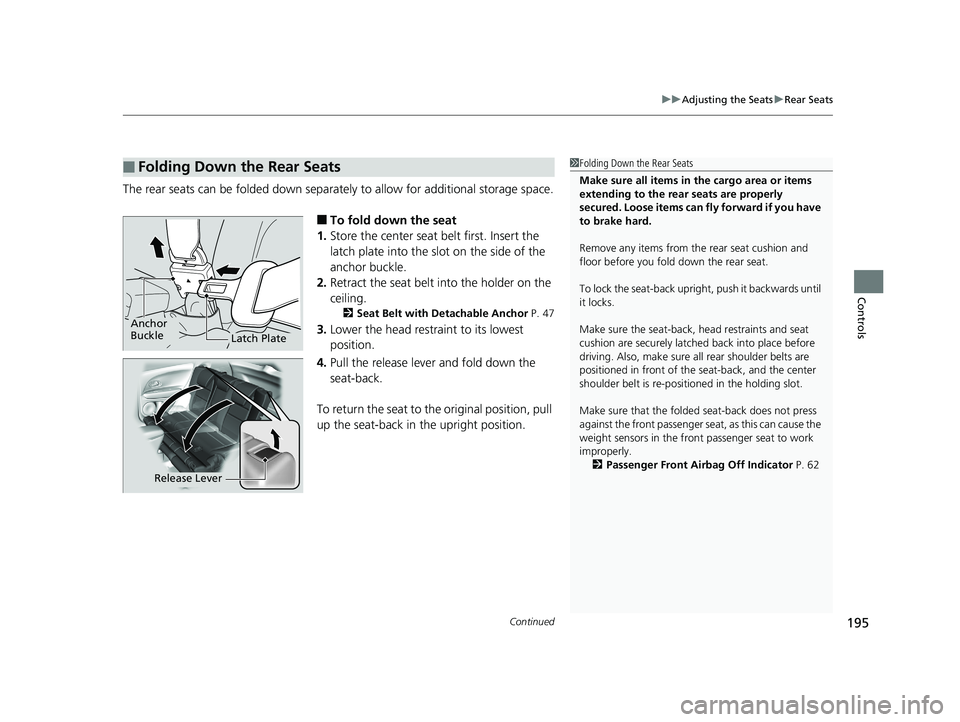
Continued195
uuAdjusting the Seats uRear Seats
Controls
The rear seats can be folded down separa tely to allow for additional storage space.
■To fold down the seat
1. Store the center seat belt first. Insert the
latch plate into the slot on the side of the
anchor buckle.
2. Retract the seat belt into the holder on the
ceiling.
2 Seat Belt with Detachable Anchor P. 47
3.Lower the head restraint to its lowest
position.
4. Pull the release lever and fold down the
seat-back.
To return the seat to th e original position, pull
up the seat-back in the upright position.
■Folding Down the Rear Seats1 Folding Down the Rear Seats
Make sure all items in the cargo area or items
extending to the rear seats are properly
secured. Loose items can fly forward if you have
to brake hard.
Remove any items from th e rear seat cushion and
floor before you fold down the rear seat.
To lock the seat-back upri ght, push it backwards until
it locks.
Make sure the seat-back, head restraints and seat
cushion are securely latche d back into place before
driving. Also, make sure all rear shoulder belts are
positioned in front of the seat-back, and the center
shoulder belt is re-posit ioned in the holding slot.
Make sure that the folded seat-back does not press
against the front passenger seat, as this can cause the
weight sensors in the front passenger seat to work
improperly.
2 Passenger Front Airbag Off Indicator P. 62
Anchor
Buckle
Latch Plate
Release Lever
19 HR-V HDMC HDMG-31T7A6300.book 195 ページ 2018年6月1日 金曜日 午後1時14分
Page 419 of 631
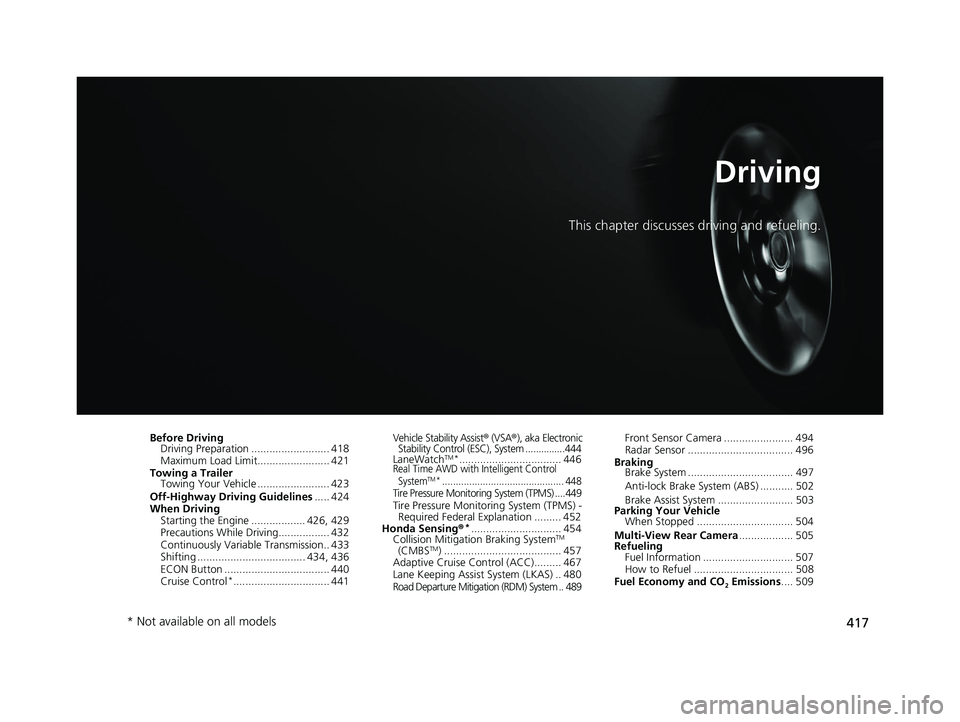
417
Driving
This chapter discusses driving and refueling.
Before DrivingDriving Preparation .......................... 418
Maximum Load Limit........................ 421
Towing a Trailer Towing Your Vehicle ........................ 423
Off-Highway Driving Guidelines ..... 424
When Driving Starting the Engine .................. 426, 429
Precautions While Driving................. 432
Continuously Variable Transmission.. 433
Shifting .................................... 434, 436
ECON Button ................................... 440
Cruise Control
*................................ 441
Vehicle Stability Assist® (VSA®), aka Electronic
Stability Control (ESC), System ...............444
LaneWatchTM*.................................. 446Real Time AWD with Intelligent Control
SystemTM*............................................. 448Tire Pressure Monito ring System (TPMS) ....449Tire Pressure Monitoring System (TPMS) -
Required Federal Explanation ......... 452
Honda Sensing ®
*.............................. 454
Collision Mitigati on Braking SystemTM
(CMBSTM) ....................................... 457
Adaptive Cruise Control (ACC)......... 467
Lane Keeping Assist System (LKAS) .. 480
Road Departure Mitigation (RDM) System .. 489
Front Sensor Camera ....................... 494
Radar Sensor ................................... 496
Braking Brake System ................................... 497
Anti-lock Brake System (ABS) ........... 502
Brake Assist System ......................... 503
Parking Your Vehicle When Stopped ................................ 504
Multi-View Rear Camera .................. 505
Refueling Fuel Information .............................. 507
How to Refuel ................................. 508
Fuel Economy and CO
2 Emissions .... 509
* Not available on all models
19 HR-V HDMC HDMG-31T7A6300.book 417 ページ 2018年6月1日 金曜日 午後1時14分
Page 459 of 631
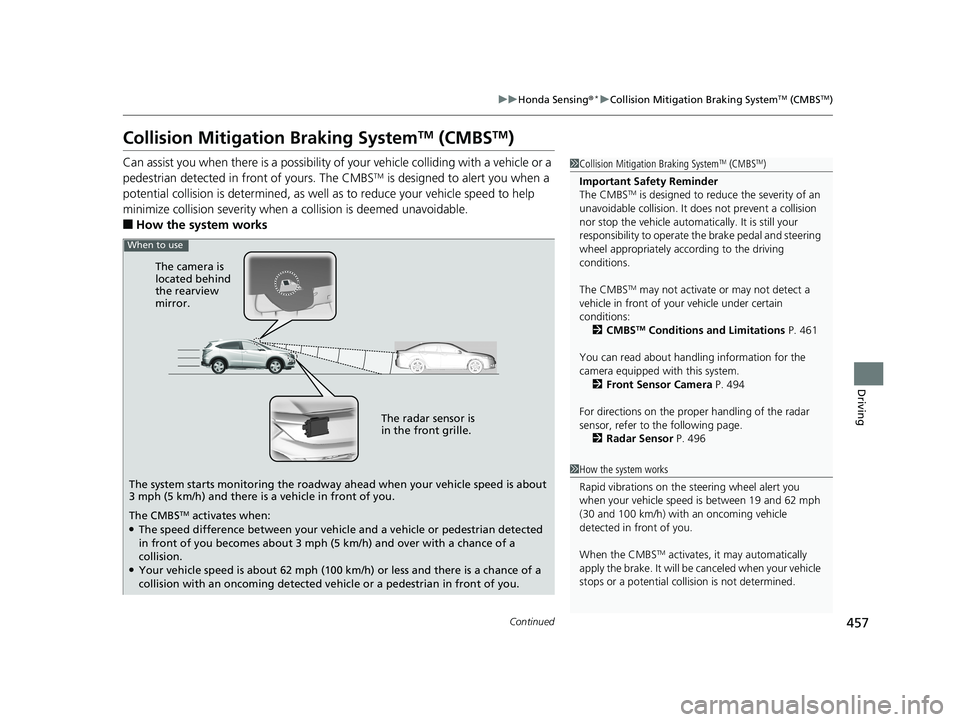
457
uuHonda Sensing ®*uCollision Mitigation Braking SystemTM (CMBSTM)
Continued
Driving
Collision Mitigation Braking SystemTM (CMBSTM)
Can assist you when there is a possibility of your vehicle colliding with a vehicle or a
pedestrian detected in front of yours. The CMBSTM is designed to alert you when a
potential collision is determined, as well as to reduce your vehicle speed to help
minimize collision severity when a collision is deemed unavoidable.
■How the system works
1 Collision Mitigation Braking SystemTM (CMBSTM)
Important Safety Reminder
The CMBS
TM is designed to reduce the severity of an
unavoidable collision. It do es not prevent a collision
nor stop the vehicle automati cally. It is still your
responsibility to operate the brake pedal and steering
wheel appropriately acco rding to the driving
conditions.
The CMBS
TM may not activate or may not detect a
vehicle in front of y our vehicle under certain
conditions:
2 CMBS
TM Conditions and Limitations P. 461
You can read about handling information for the
camera equipped with this system. 2 Front Sensor Camera P. 494
For directions on the prop er handling of the radar
sensor, refer to the following page. 2 Radar Sensor P. 496
1How the system works
Rapid vibrations on the steering wheel alert you
when your vehicle speed is between 19 and 62 mph
(30 and 100 km/h) with an oncoming vehicle
detected in front of you.
When the CMBS
TM activates, it may automatically
apply the brake. It will be canceled when your vehicle
stops or a potential coll ision is not determined.
When to use
The camera is
located behind
the rearview
mirror.
The radar sensor is
in the front grille.
The system starts monitoring the roadway ahead when your vehicle speed is about
3 mph (5 km/h) and there is a vehicle in front of you.
The CMBS
TM activates when:●The speed difference between your vehicl e and a vehicle or pedestrian detected
in front of you becomes about 3 mph (5 km/h) and over with a chance of a
collision.
●Your vehicle speed is about 62 mph (100 km/h) or less and there is a chance of a
collision with an oncoming detected ve hicle or a pedestrian in front of you.
19 HR-V HDMC HDMG-31T7A6300.book 457 ページ 2018年6月1日 金曜日 午後1時14分
Page 464 of 631
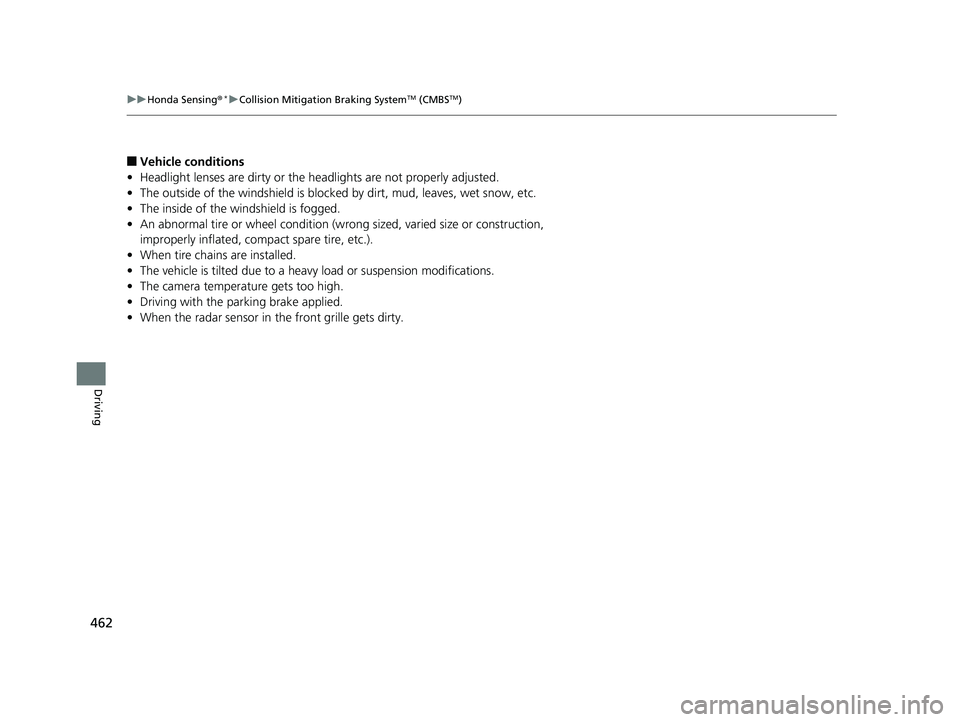
462
uuHonda Sensing ®*uCollision Mitigation Braking SystemTM (CMBSTM)
Driving
■Vehicle conditions
• Headlight lenses are dirty or the headlights are not properly adjusted.
• The outside of the windshie ld is blocked by dirt, mud, leaves, wet snow, etc.
• The inside of the windshield is fogged.
• An abnormal tire or wheel condition (wrong sized, varied size or construction,
improperly inflated, comp act spare tire, etc.).
• When tire chains are installed.
• The vehicle is tilted due to a heav y load or suspension modifications.
• The camera temperature gets too high.
• Driving with the parking brake applied.
• When the radar sensor in the front grille gets dirty.
19 HR-V HDMC HDMG-31T7A6300.book 462 ページ 2018年6月1日 金曜日 午後1時14分
Page 465 of 631
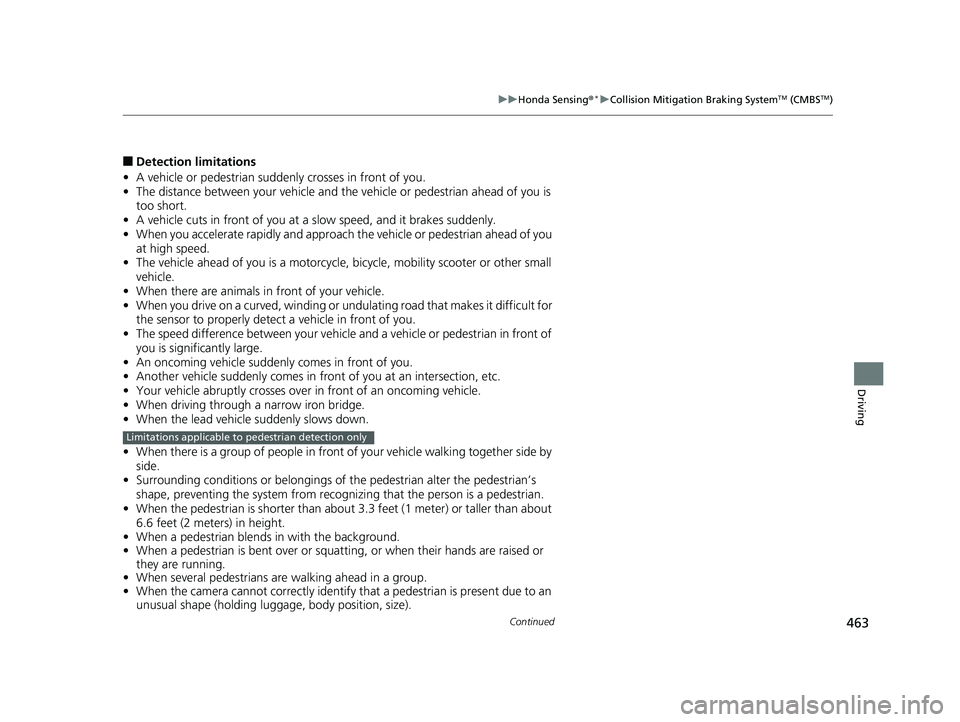
463
uuHonda Sensing ®*uCollision Mitigation Braking SystemTM (CMBSTM)
Continued
Driving
■Detection limitations
• A vehicle or pedestrian suddenly crosses in front of you.
• The distance between your vehicle and the vehicle or pedestrian ahead of you is
too short.
• A vehicle cuts in front of you at a slow speed, and it brakes suddenly.
• When you accelerate rapidly and approach the vehicle or pedestrian ahead of you
at high speed.
• The vehicle ahead of you is a motorcycle, bicycle, mobility scooter or other small
vehicle.
• When there are animals in front of your vehicle.
• When you drive on a curved, winding or und ulating road that makes it difficult for
the sensor to properly detect a vehicle in front of you.
• The speed difference between your vehicle an d a vehicle or pedestrian in front of
you is significantly large.
• An oncoming vehicle suddenly comes in front of you.
• Another vehicle suddenly comes in front of you at an intersection, etc.
• Your vehicle abruptly crosses over in front of an oncoming vehicle.
• When driving through a narrow iron bridge.
• When the lead vehicl e suddenly slows down.
• When there is a group of people in front of your vehicle walking together side by
side.
• Surrounding conditions or belongings of the pedestrian alter the pedestrian’s
shape, preventing the system from recogn izing that the person is a pedestrian.
• When the pedestrian is shorte r than about 3.3 feet (1 meter) or taller than about
6.6 feet (2 meters) in height.
• When a pedestrian blends in with the background.
• When a pedestrian is bent over or squatting, or when their hands are raised or
they are running.
• When several pedestrians are walking ahead in a group.
• When the camera cannot correctly identify that a pedestrian is present due to an
unusual shape (holding luggage, body position, size).
Limitations applicable to pedestrian detection only
19 HR-V HDMC HDMG-31T7A6300.book 463 ページ 2018年6月1日 金曜日 午後1時14分
Page 469 of 631
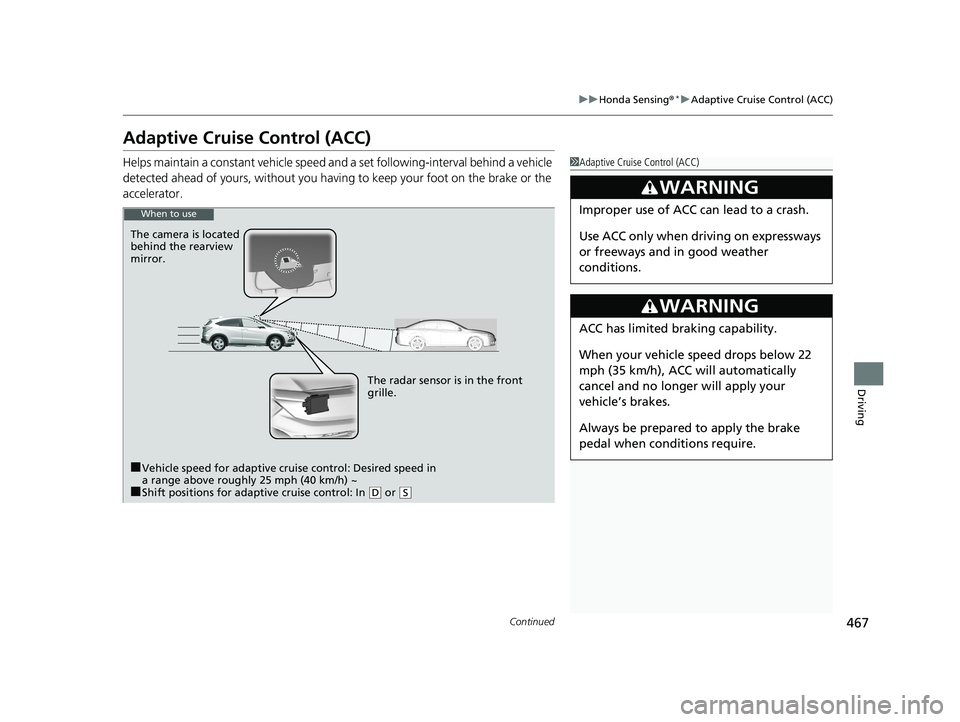
467
uuHonda Sensing ®*uAdaptive Cruise Control (ACC)
Continued
Driving
Adaptive Cruise Control (ACC)
Helps maintain a constant vehicle speed an d a set following-interval behind a vehicle
detected ahead of yours, without you having to keep your foot on the brake or the
accelerator.1 Adaptive Cruise Control (ACC)
3WARNING
Improper use of ACC can lead to a crash.
Use ACC only when driving on expressways
or freeways and in good weather
conditions.
3WARNING
ACC has limited braking capability.
When your vehicle speed drops below 22
mph (35 km/h), ACC will automatically
cancel and no longer will apply your
vehicle’s brakes.
Always be prepared to apply the brake
pedal when conditions require.
When to use
The camera is located
behind the rearview
mirror.
The radar sensor is in the front
grille.
■Vehicle speed for adaptive cruise control: Desired speed in
a range above roughly 25 mph (40 km/h) ~
■Shift positions for adaptive cruise control: In ( D or (S
19 HR-V HDMC HDMG-31T7A6300.book 467 ページ 2018年6月1日 金曜日 午後1時14分
Page 470 of 631
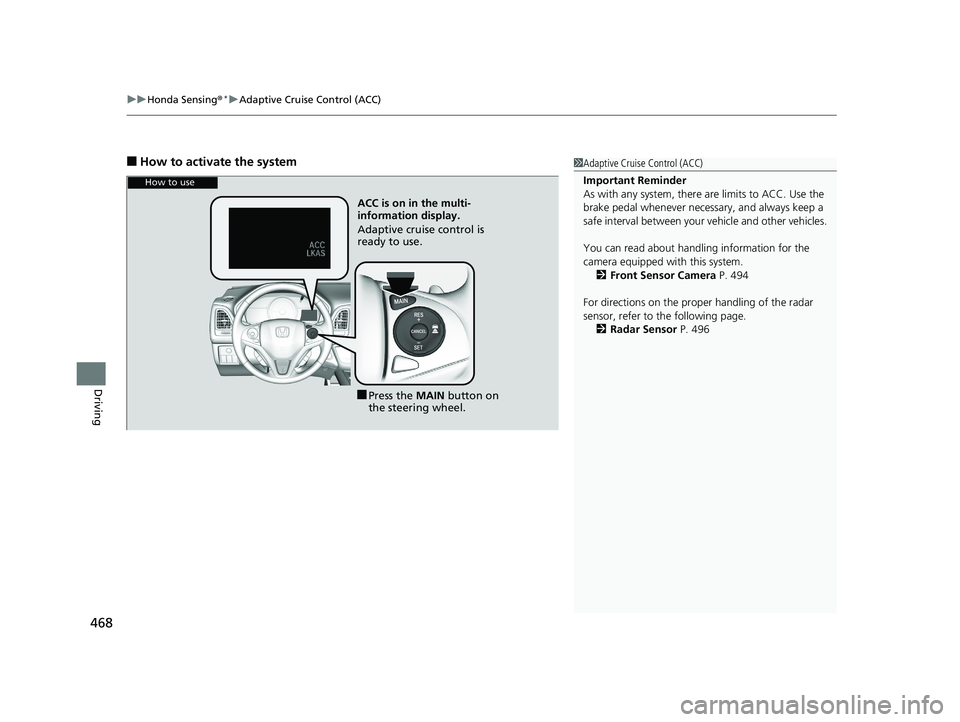
uuHonda Sensing ®*uAdaptive Cruise Control (ACC)
468
Driving
■How to activate the system1Adaptive Cruise Control (ACC)
Important Reminder
As with any system, there are limits to ACC. Use the
brake pedal whenever necessary, and always keep a
safe interval betw een your vehicle and other vehicles.
You can read about handling information for the
camera equipped with this system. 2 Front Sensor Camera P. 494
For directions on the prop er handling of the radar
sensor, refer to the following page.
2 Radar Sensor P. 496
How to use
ACC is on in the multi-
information display.
Adaptive cruise control is
ready to use.
■Press the MAIN button on
the steering wheel.
19 HR-V HDMC HDMG-31T7A6300.book 468 ページ 2018年6月1日 金曜日 午後1時14分